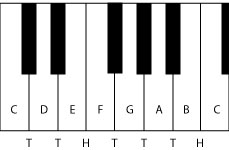Today we are going to learn what intervals and scale degrees are. This will help us understand the difference between, for example, major and minor interval sounds, which usually account for the biggest differences when we hear a certain scale or sequence of sounds.
In order to understand this, let’s start by picking up the C major scale:
C, D, E, F, G, A, B and C again

The piano roll is very useful to visualize the jumps, or intervals between the notes. Every time we can count one key between two notes in the scale of C major, we have what we call a whole tone, or simply a Tone (T); when there are no keys between two adjacent notes in the scale, we have a Half-tone (H).
In the scale of C major the sequence of Tones and Half-tones is shown by the Ts and the Hs written below the piano roll. In this sense, every time we think about a Major scale, we should have in mind the sequence of tones and half-tones: T – T – H – T – T – T – H.
Having this clear, we can go on thinking about the relation between the root note of the scale, the C in this case, and the other notes. This relation is very important, as it gives each scale a peculiar sound, a character of its own. Handpan scales rely very much on these differences, and in this lesson we are going to learn how this works, applied to the Major scale.
Using the C as our pivot, we are going to count how many tones or half-tones there are between the root note and the other notes. Let’s start:
- C to D: one tone; this is called a major 2nd interval
- C to E: two tones; this is called a major 3rd interval
- C to F: two tones and a half; this is called a perfect 4th interval
- C to G: three tones and a half; this is called a perfect 5th interval
- C to A: four tones and a half; this is called a major 6th interval
- C to B: five tones and a half; this is called a major 7th interval
- C to the next C: 6 tones; this is called an octave interval or unison
These intervals make up the main features of a major scale. If we decided to change one, then we would have a different scale, with a different feeling and character. This is why we often refer to major or minor scales, for examples. We’ll understand this better when we’ll learn about modes and modal scales.
For now, just try to familiarize with the terminology, and listen to the sound of major and minor scales, to feel their different taste and mood.


thank you so much, this helped me immensely as i have no knowledge about music theory and never played any instrument before and i couldn’t figure out what some lessons meant by 3rds and 4ths so THIS made it clear for me. Thank you!